
Where is the Japanese fleet, Lieutenant Narwhal ?
We have no idea, Admiral !
Where are we looking for them ?
We have no idea, Admiral ! We received a note stating that scouting has been “streamlined”.
Midway campaign starts the 3rd of June 1942, mid-day, after some early inconclusive skirmishes between land-bound planes and the Japanese. The Japanese are approaching the strategic island of Midway with :
– an invasion force,
– an escort by a cruiser squadron which includes a light aircraft carrier (the Zuiho),
– a “strike force” of four aircraft carriers (the Akagi, the Kaga, the Hiryu and the Soryu) and its escorts,
Facing them, the Americans have assembled two task forces :
– Task Force 16 with two aircraft carriers (the USS Hornet and the USS Entreprise) and escorts,
– Task Force 17 with one aircraft carrier (the USS Yorktown) and escorts,
They will be supported by the Midway Airbase land-bound planes.
In the Battle of Midway, any ship that did not carry planes was irrelevant except as floating anti-air battery, and as such they are not represented in the game.
I seem very confident right now describing the battle, but I had to look on Wikipedia to see which task force included which aircraft carrier, even though as you will see it is kinda relevant to the game (it is mentioned in the one-page historical background that is part of the manual).
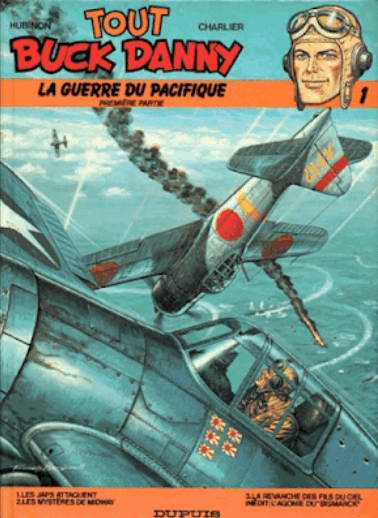
We will play the Americans (the only faction playable), and for the purpose of the story I will feign ignorance of the location of the Japanese force because, you see, the AI always starts in the same exact position and always behaves the same. Not that you can do much with this information, as you do not control the scouting operations and you cannot attack what you cannot see.
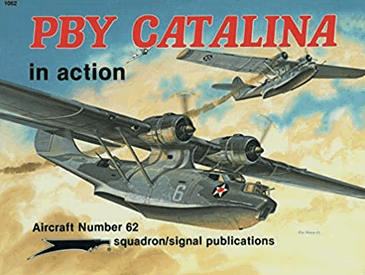
The player is given command of Task Force 16 and Task Force 17, initially located in the top left corner of the battle area. Midway is in the relative center of the map.
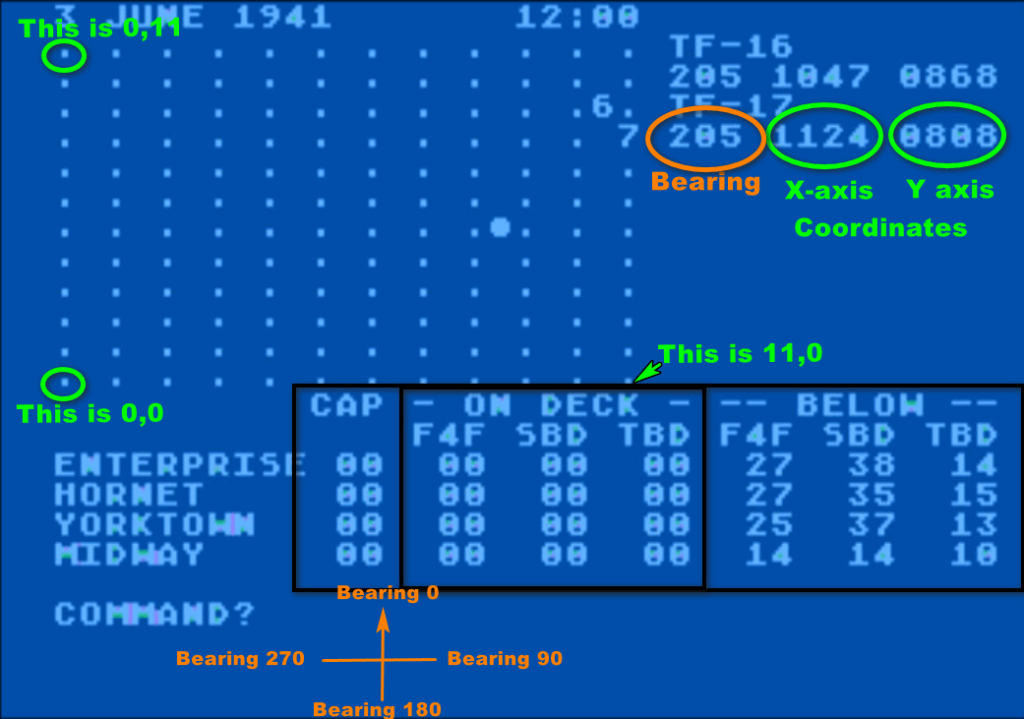
For this battle, I decided not to exploit the fact that I knew the exact Japanese location, nor to “unrealistically” put all the fighters (noted F4F above, for F4F Wildcats) on my carriers in patrol mission [CAP, for Combat Air Patrol] missions until the Japanese are spotted. Letting the game run historically as long as no hostile fleet is detected, Task Force 16 and Task Force 17 head toward Midway.
For reference, my fighters will fight their Japanese equivalent (the Zeke), Japanese bombers (the Val) and Japanese torpedo bombers (the Kate)
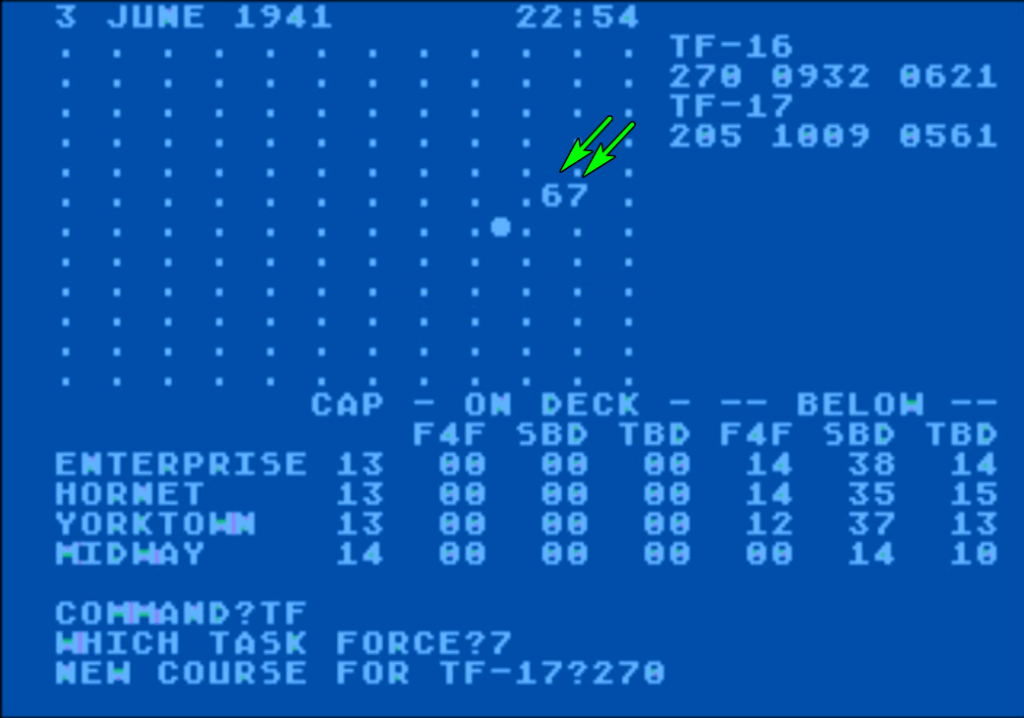
Nothing happens the 3rd of June.
On the 4th of June, a fleet is detected South West. I decide to keep patrolling around Midway while the Japanese fleet approaches :
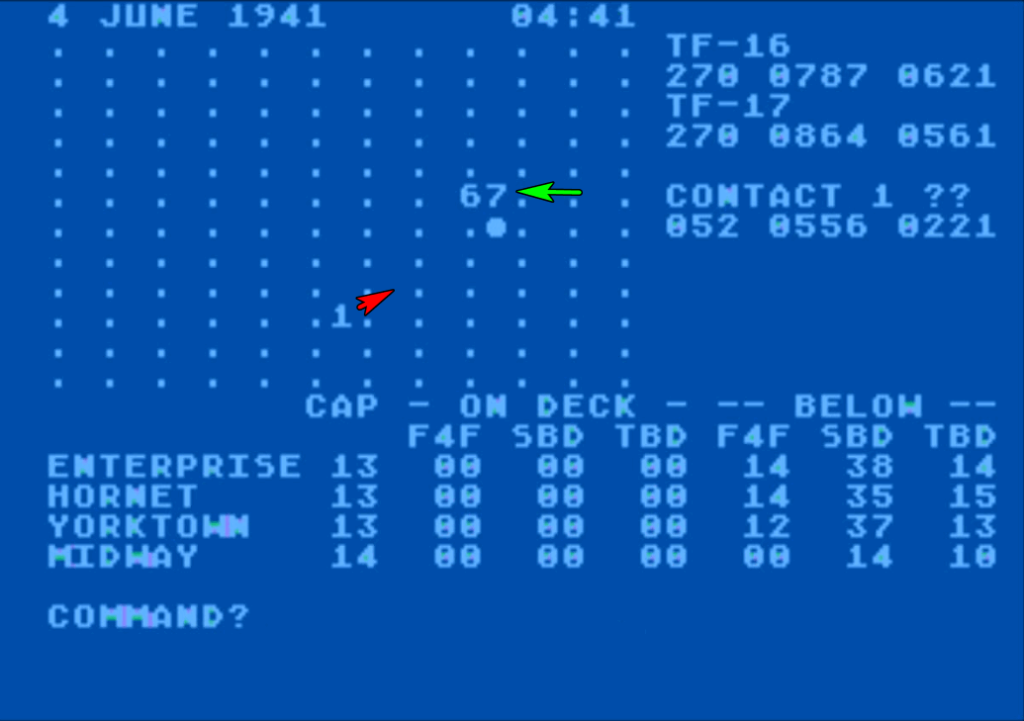
Suddenly, out of nowhere, the Japanese mock my fair play and attack !


Wait what ?



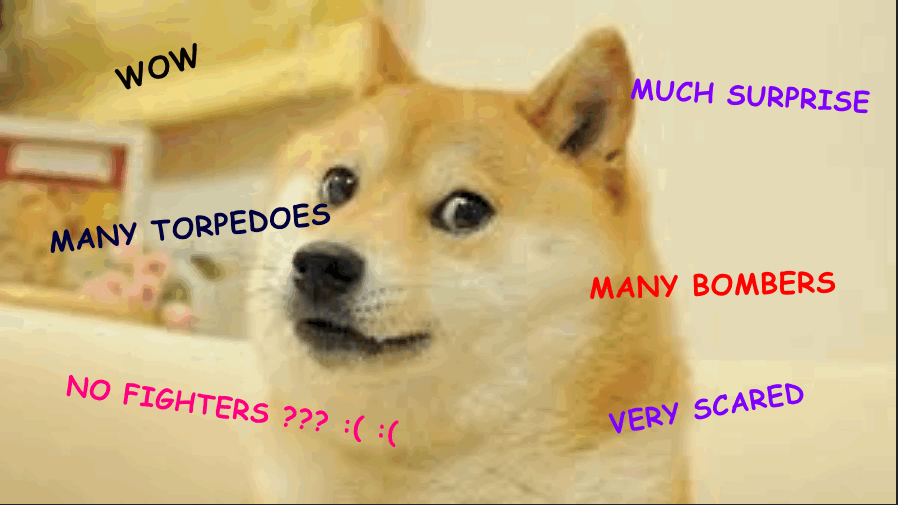
That’s 84 Torpedo bombers attacking the Yorktown. The secret to dodging 84 torpedoes is that you don’t dodge 84 Torpedoes. Consequently :
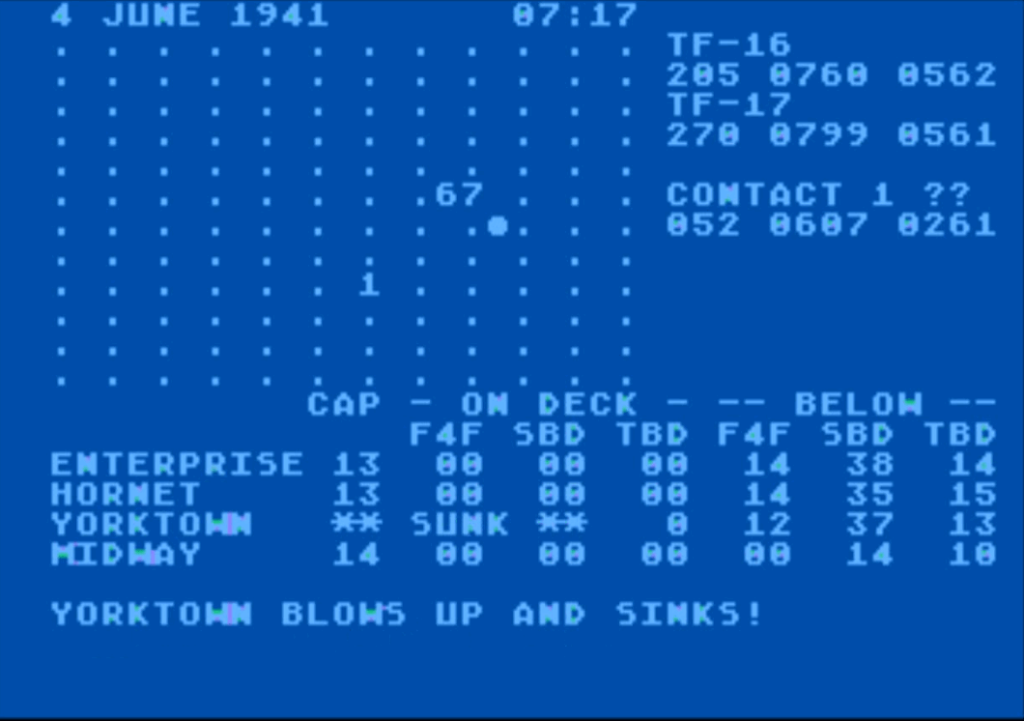
What a start ! I am totally in control of the situation !
If there is a silver lining, it is that I lost only one carrier, and the enemy strike force from which the attack came is now detected :
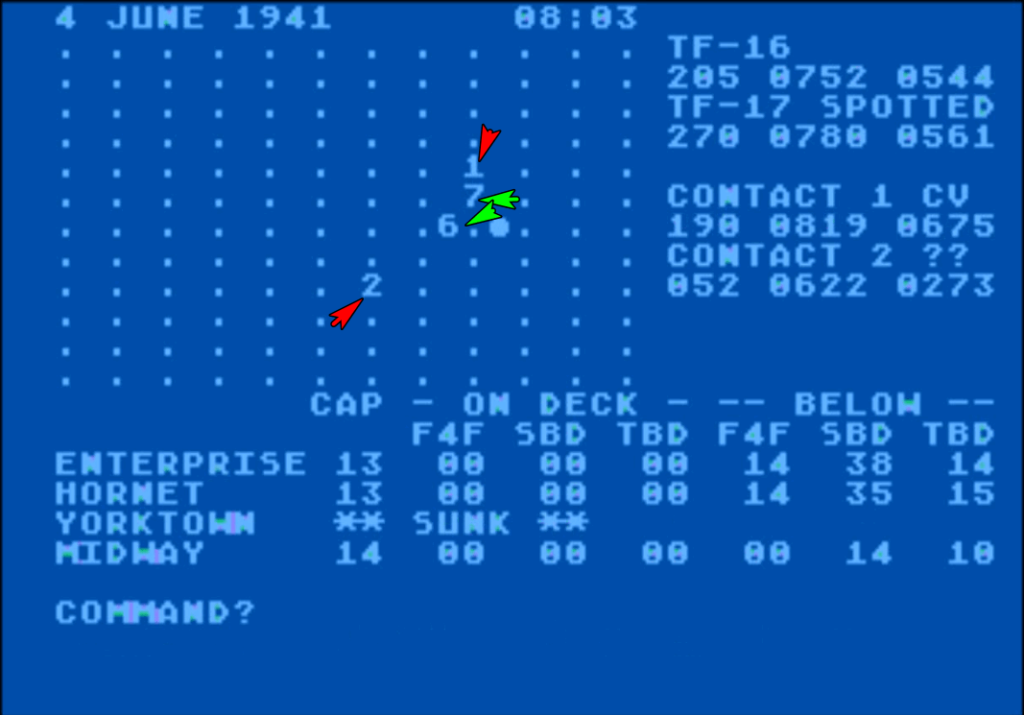
It is close to both Midway and to Task Force 16 and its two carriers, and as such Every. Single. Plane. I still have is sent to attack it :
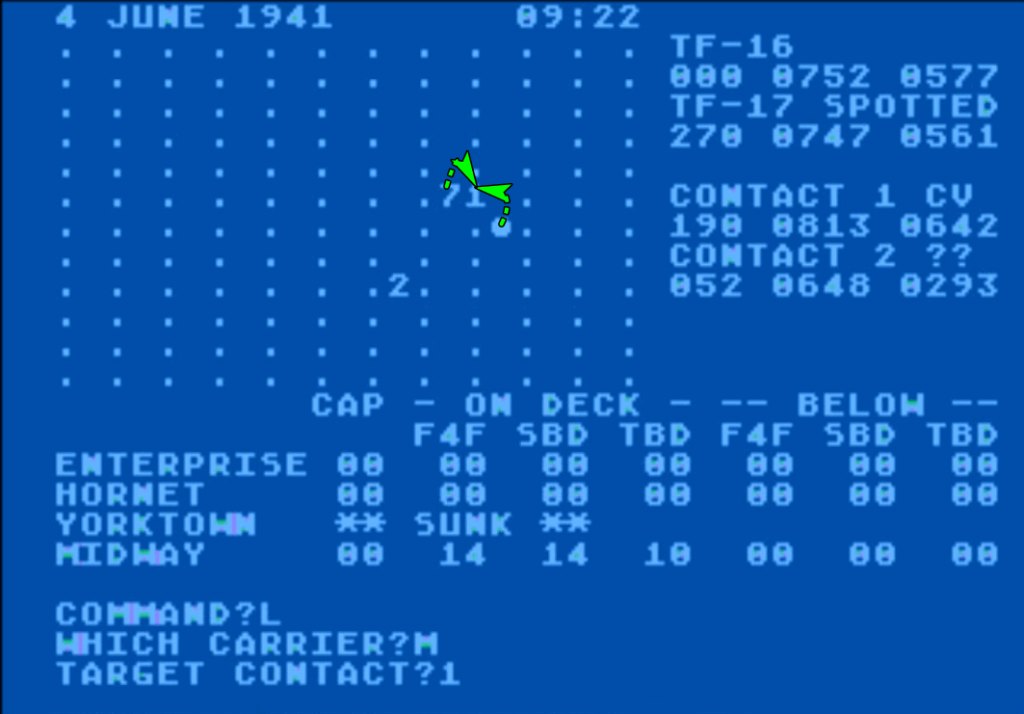
But the planes arrive one after the other rather than as a block. Enemy CAP is there, and shoots down most of the dive bombers (SBD Dauntless) from the USS Enterprise, as my fighters chose to rather escort the torpedo bombers (TBD Devastator) attempting ineffective runs on the enemy ships.
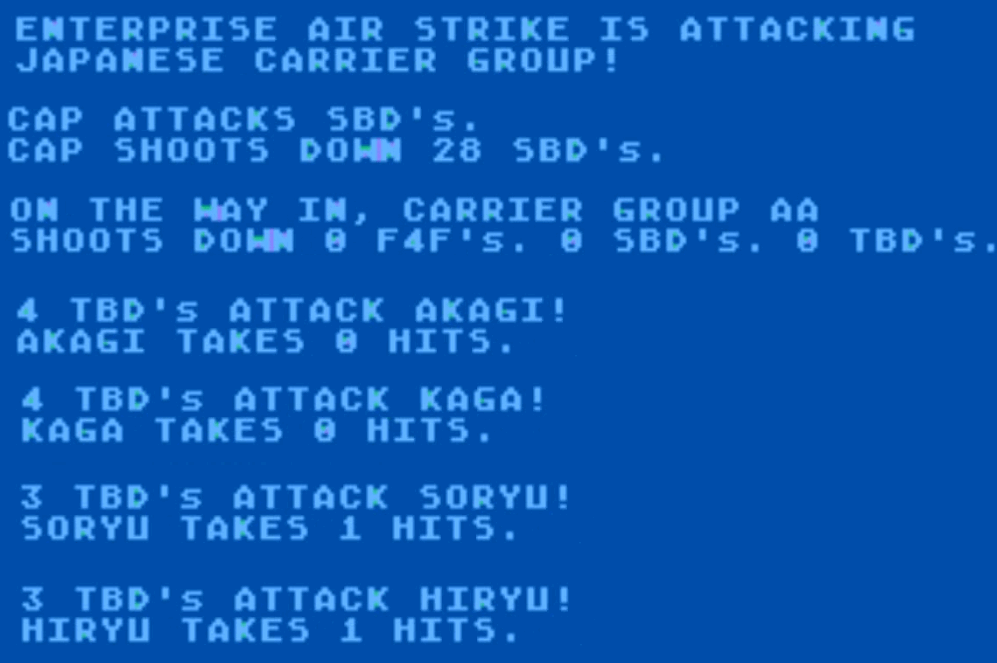
The rare surviving dive bombers don’t perform much better, and the Japanese carrier group gets out mostly undamaged from the first attack.
The planes from the Hornets arrive later, and this time it is the Devastators that are destroyed. The dive bombers inflict significant damage to the Hiryu and some minor damage to the 3 other carriers.
Finally, the planes from Midway arrive almost one hour after everyone and deal no damage. The Japanese ships did not have planes full of fuel and ordnance on their decks ready to trigger a massive fire…
… because at that moment those planes were flying toward Midway :
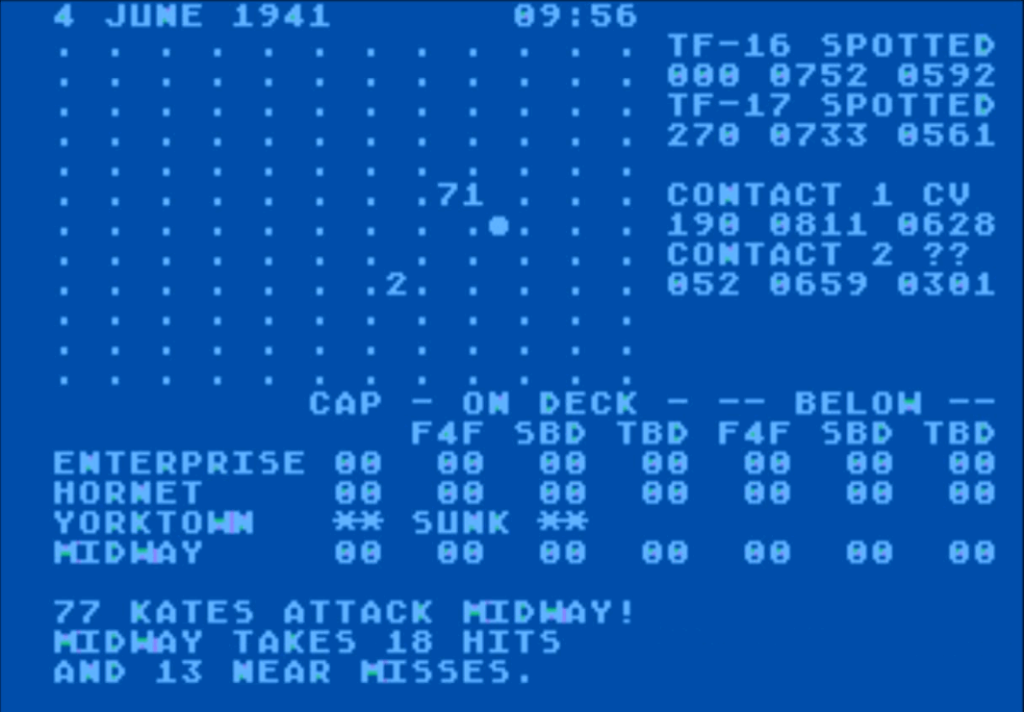
The Japanese Strike Force is still out there, but so is my Carrier Fleet. The planes are sent again, one hour later.
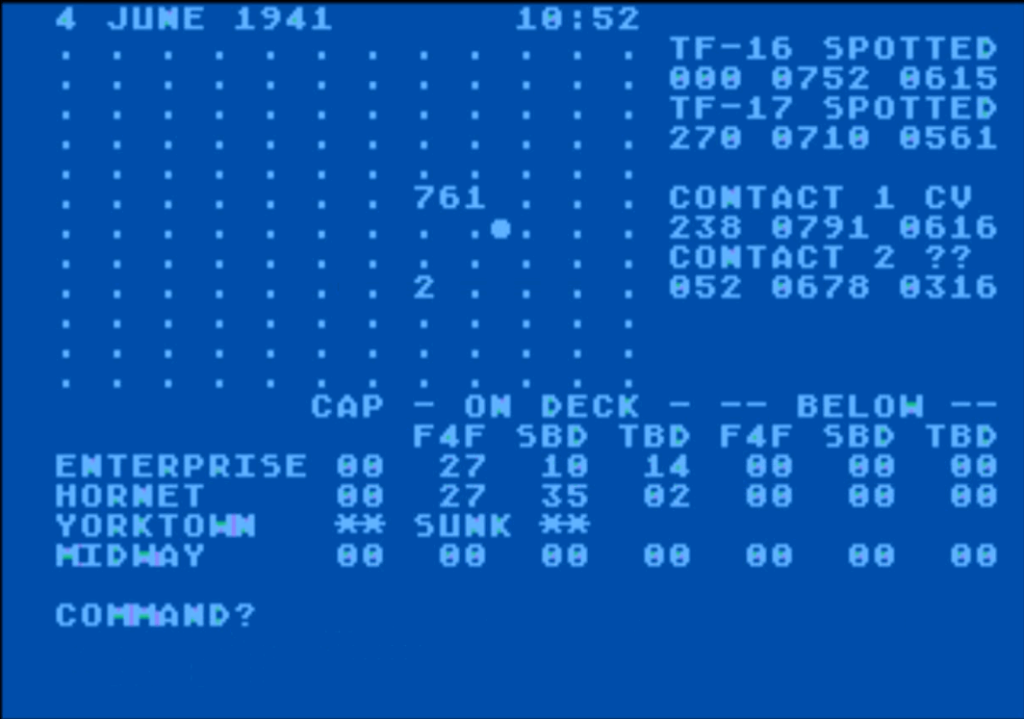
Sadly, the USS Enterprise teeth – the dive bombers – has been pulled out already, though this time the fighters engaged the Zekes, and destroyed a good number of them. This should open the way for the Hornet planes, except …

One hour and a half later, it is time for a third attack :
Sadly, as soon as my planes take off, the Japanese planes are on the horizon :

The USS Hornet is destroyed, but its air group manages to put the Akagi and the Hiryu out of commission – though does not destroy them. Meanwhile, the USS Enterprise air group is as ineffective as ever.
We are now at one carrier against two. The surviving planes from the Hornet land on the Enterprise, so maybe I still have a fighting chance.

I am readying for another strike. All the planes are on deck, ready to take off.
Suddenly :
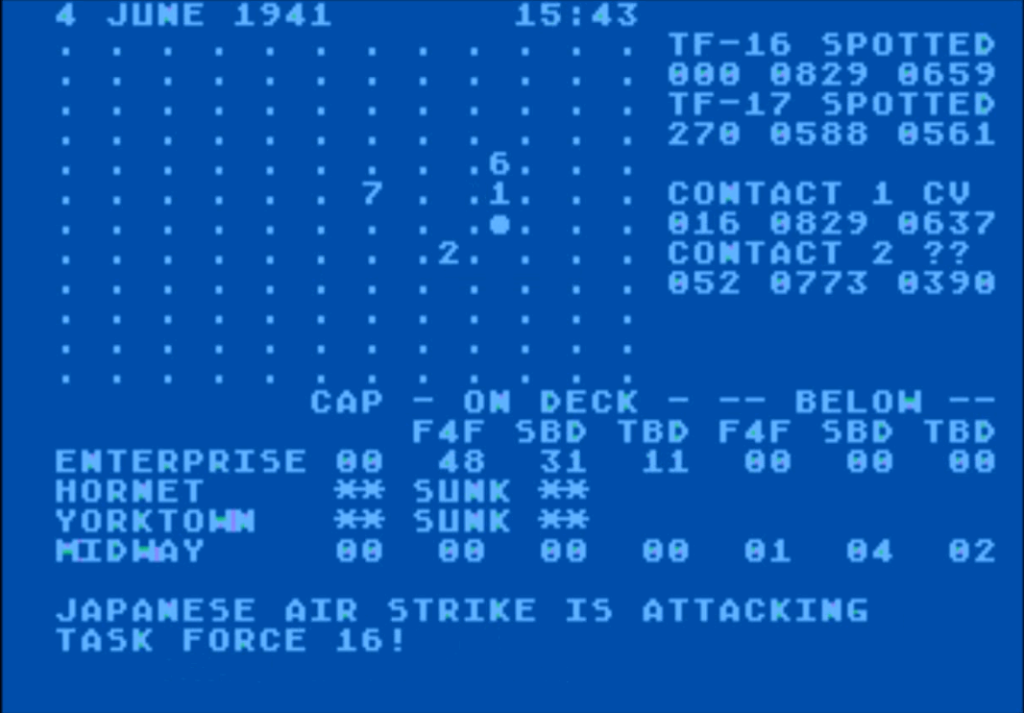
With all the planes on deck, there is absolutely nothing the USS Enterprise can do, and consequently :
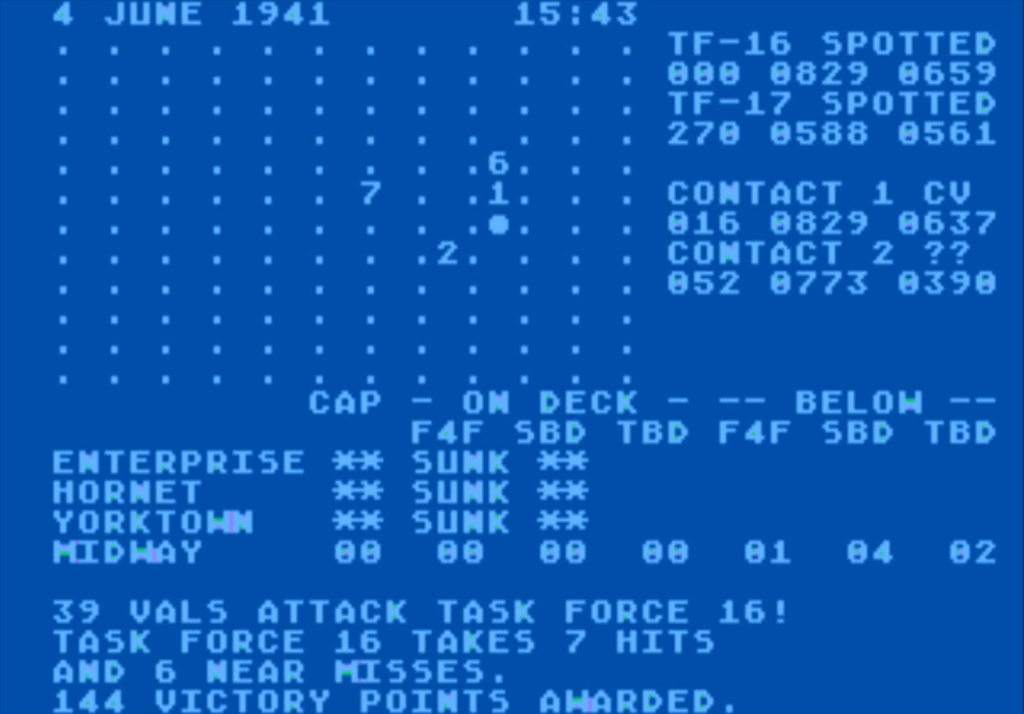
The USS Enterprise is annihilated. It is the end. The Japanese even have the luxury of inflicting so much extra damage on the task force that they receive extra points ! With all my carriers lost, I have nothing to protect Midway, which is invaded by the transport fleet. The Japanese have won !
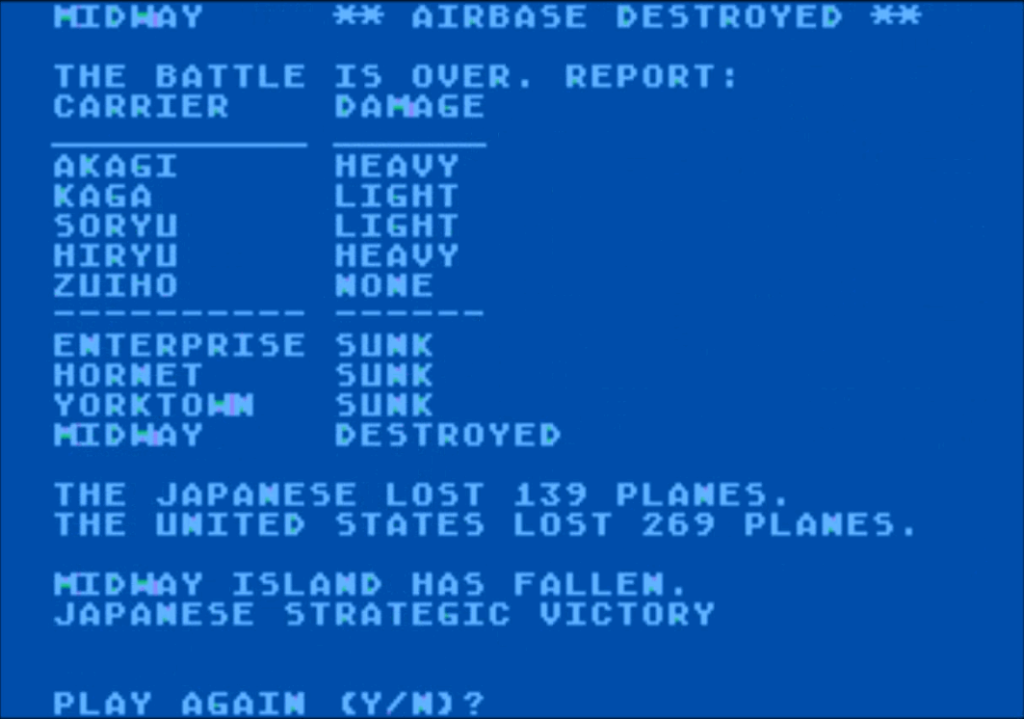
Looking back, this play was a typical show of the huge weaknesses of Campaign Midway : everything relies on having the first strike, but you have no control whatsoever on the scouting so you just hope to be more lucky than the Japanese. If the Japanese attack you first and (as would be likely in such a case) you lose a carrier, there is little you can do. I had tests where I had allocated all my Task Force 6 fighters in CAP, and still the Japanese sunk both carriers during their first attack that came from nowhere.
Not that you should NOT use all your fighters as CAP, since the game has no Carrier Launch & Recovery Cycle Management except the fact that you need to wait one hour/turn between arming the aircrafts and launching them for a strike. CAP planes can be allocated in and out of CAP instantly at any time. I decided to be a bit realistic there, and may have lost the Yorktown due to this.
In retrospect, I do not think there was any strategic decision to make after I chose not to exploit my knowledge of the scenario. The destruction of the Yorktown came from nowhere and after that both fleets were in sight and in range of each other, and in this game the only reasonable action in this situation is to send everything against the Japanese, which I did.
I managed to attack three times in total with two carriers worth of planes (in addition to Midway’s planes), but I only managed to incapacitate two aircraft carriers during the 5th or 6th attack. Historically the Americans destroyed three of the four Japanese carriers with one attack with three carriers worth of planes. The Japanese, on the other hand, destroyed one of my aircraft carriers by attack – and I know by experience that CAP would have been irrelevant.
Certainly, this outcome was not unrealistic, a lot of luck was involved in those battles of the Pacific War – but it does not make for great gameplay.
Ratings & Review
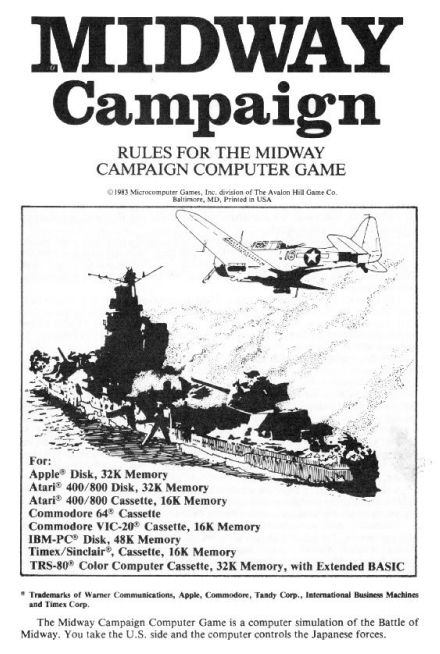
Midway Campaign by Avalon Hill, USA
First release : Summer 1980 on Apple II, Commodore PET, TRS-80
Tested on : Atari
Total Hours Tested : 3
Average duration of a battle : 10-15 minutes
Difficulty: Trivial (0/5)
Would recommend to a modern player : No
Would recommend to a designer : No
Final Rating: 15/100
Avalon Hill decided to enter the computer market with five games released together in summer 1980 : Midway Campaign, North Atlantic Convoy Raider, NukeWar, B-1 Nuclear Bomber and Planet Miner. Those games were released on almost all platforms possible at a budget price, but also at a budget size : at least three versions of each game had to fit on one cassette.
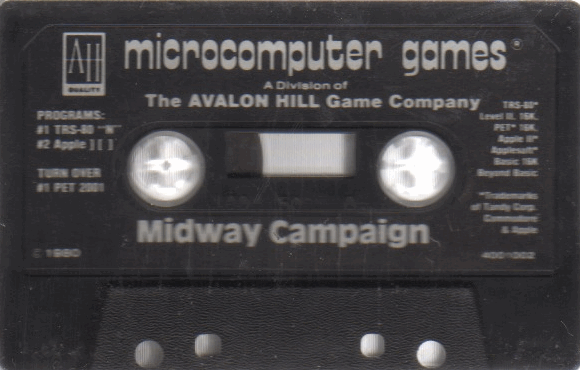
The best of those games is probably the one which is not a wargame : Planet Miners. I will cover the four others.
The real battle of Midway was the perfect setting for a computer game of the heroic era : it was probably the most decisive battle of the Pacific war, and yet it involved only a limited number of moving parts, almost exclusively at sea which is certainly easier to represent than land.
A. Settings & Aesthetics
As you read the manual or reach the first screen of the game, the game feels like a labour of love with strong attention to detail. This goes far : for instance Japanese and Americans follow different rules for repairing ships, and the carriers have the historical number of planes.
This feeling quickly vanishes as soon as the pieces start moving, and you realize that the efforts have been allocated to the superfluous but not to the necessary : you will see torpedo bombers attacking the Midway airbase, you will see absurd numbers of planes on deck at the same time (in one of my tests I had more than 100) and you will see enemy fleets traversing each other as if nothing happened.
There are obviously no graphics.
Score : 4/20
B. UI , Clarity of rules and outcomes
The UI is clear, by virtue of being so simple.
As a player, you have very few actions available :
- You control the bearing of the two Task Forces (but not their speed which is constant),
- You can give exactly four orders to your planes :
– Combat Air Patrol [CAP] : Orders any number of fighters to patrol over your carrier or base,
– Arm the planes, which means moving the planes on deck to prepare them for a strike, leaving them and the carrier vulnerable,
– Launch a strike on a fleet on range (200nm, so 2 “dots” on the map), once your planes have been moved on deck,
– Clear the deck, which is of course moving the planes from above deck to below deck.
And … that’s all. You cannot relocate planes between carriers or to Midway. You cannot move carriers from one task force to another. Even reconnaissance is done automatically by (invisible) PBY Catalina. The game automatically makes sure that you do not send planes on suicide missions or that you do not send planes if they will be unable to come back before dark (1900 to 0400).

As for the outcomes, they feel extremely random, both for the individual engagements (sometimes my fighters shot down dozens of Zekes with no losses on my side, and sometimes the Zekes shot down dozens of my fighters with no loss on their side) and for the result of the campaign. While this can be construed as realistic given the nature of the Pacific War, a little more explanation on what happened when all your fighters were shot down would have made this randomness much more acceptable.
Score : 4/20
That would have been even worse if I had not played on an Atari Emulator :
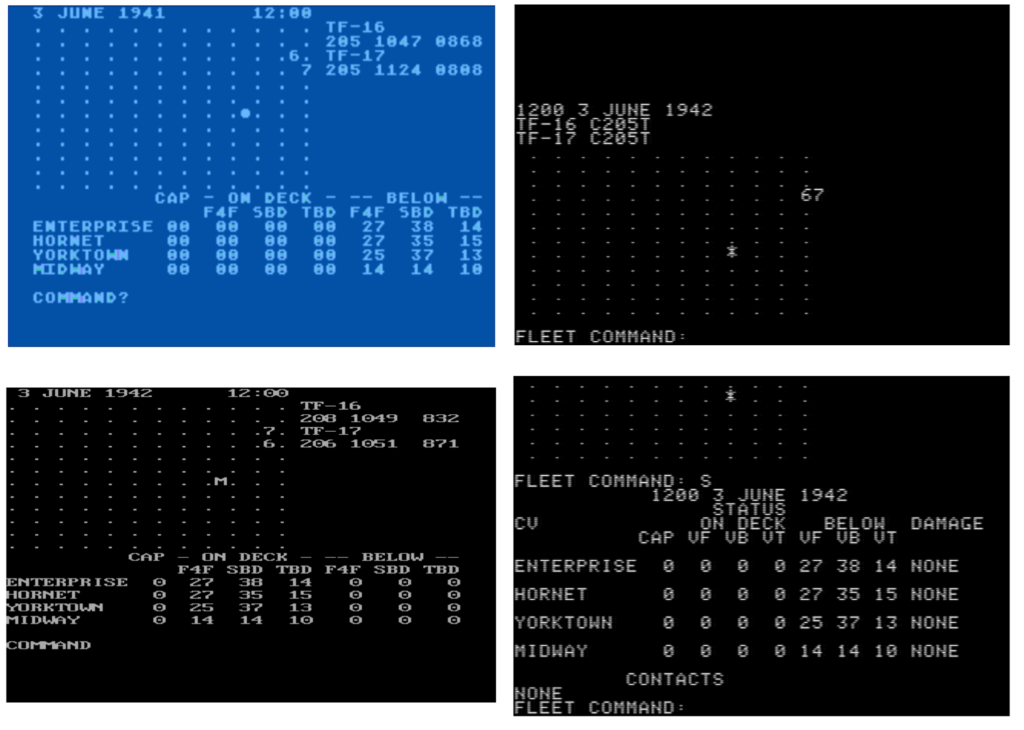
C. Systems
The strategic layer consists of putting all your planes in CAP and then waiting for the random number generator to find the enemy fleet.
The tactical layer starts when you have found the enemy fleet ; it consists of sending all your planes against that fleet and hoping for the best.
Overall, the game feels like a roulette with extra steps.
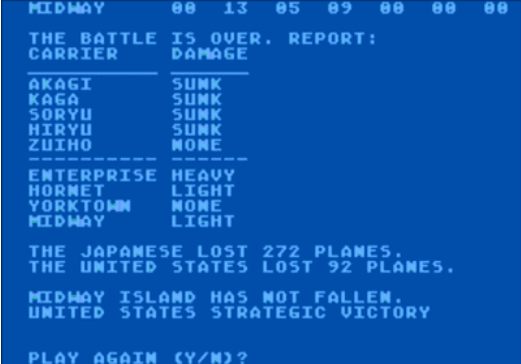
Score : 1/20
D. Scenario design & Balancing
There is only one scenario with fixed starting positions for both sides, so you quickly know exactly where every single Japanese fleet is – not that you can do much with this information given you will not be able to attack until the game tells you you detected the enemy fleet.
Worse, unlike Computer Bismarck, the AI follows exactly the same plan every game, no variation. The manual even tells you more than you ever wanted to know about the AI’s behaviour:

The scenario has three Japanese fleets, but actually only one matters, and 90% of my tests were over before the end of the second day, and thus before the transport fleet, the cruiser fleet and the Zuiho even came in range of Midway.
Score : 3/20
E. “Fun” and Replayability
Midway Campaign feels like an adventure game : it is fun exactly once, when you have not realized yet you are being railroaded by the game intrinsic randomness. After that I felt like I was only playing to test, or to write the After Action Report above.
Score : 3/20
F. Final rating
15/100. It could have been a decent game if I wanted to teach the battle of Midway to a class – but it fails at doing anything beyond that. Midway Campaign was made by connoisseurs of the Pacific War, but connoisseurs who did not manage to detach themselves enough from the events to make an acceptable game out of it.
Contemporary reviews
I could not find many reviews for Midway Campaign. In 80 Microcomputing Magazine (“the magazine for TRS-80 users“), David Tinis complains about the lack of graphics and on the fact that the player has to “sit and wait” for the results of the scouting phase. The reviewer recommends the game to those new to conflict simulations, but “advanced game strategists will probably tire of it quickly”. .
The General magazine – the magazine published by Avalon Hill – explains some of the weaknesses of the game. The General claims that the game was so large that it just barely fit in the 16K memory limit, and that therefore many elements were abstracted : ship-to-ship combat, submarines. As for search, it claims that the US Admiral in Command had no control over the operations of the scout planes. If true, this is typically a situation where gameplay should have trumped historicity.
12 Comments
Pity, particularly in comparison to Bismarck.
> 90% of what I know of the Pacific War comes from Belgium
85% of what I know of warplanes comes from Belgium. The rest comes from France with les chevaliers du ciel, though I think Buck Danny is better.
While the first couple of Buck Danny stories are very rough (it does become good with the Flying Tiger arc, and great with Les Traffiquants de la Mer Rouge), I can respect and appreciate drawing all your air-warfare knowledge from it. Tanguy Et Laverdure was neat as well, although a bit repetitive.
The comparison with Bismarck is stark, in that one it felt like you were in control all the time and payed for your mistakes fairly. For this, the Russian Roulette comparison seems very apt.
I actually have fond memories of the very first Buck Danny, and given they are so historical they are a very good introduction to the Pacific War, and I actually did not like that much the Flying Tiger arc because I don’t like stories with a traitor (and Buck Danny relies a bit too much on this trope).
After that, quality goes from the great to the bad ; in my opinion the best being “The Agressors” and “The Secrets of the Black Sea”, the latter showing for a 1993 publication an excellent understanding the weird chaos that Soviet Union was in 1991. The recent revival with “Buck Danny classic” is top notch.
I was never been a lover of Tanguy and Laverdure, though I have read them.
Tanguy and Laverdure had the problem (at least from my memory) of every single story revolving around the dastardly plot from an unnamed foreign power that tried to steal the superior and top secret latest french tech, which even young me saw as a little silly (with the benefit of hindsight, the most hillarious one had to be about the VTOL prototype). Then again, young me was a sucker for warplanes, so everything was deemed acceptable.
I don’t remember that many episodes of attempted theft of French tech , only the VTOL one. I remember a bunch of post-colonial/Françafrique episodes and a few that were copied from Buck Danny (or the other way around), though. In the same category, I read a few Dan Cooper, for the Canadian version of the character, though a few dealt with space adventures.
That’s why you stick with Les Scorpions du désert and Pratt’s childish and eternal love for all things military.
And let’s not talk about Crepax and the fact that he designed, draw and published entire historical tabletop games! In Italy! In the 60ies! I thought the guy only drew weirdo underground comics.
Kates could be fitted with bombs for land attack. They functioned as level bombers. They did a good bit of damage to Midway in this fashion.
Heck, don’t you remember the drama when Nagumo then ordered the torpedo bombers back into the hangar decks to change from torpedoes to bombs? Then they spotted the US carriers and he ordered the process reversed? And then the American dive bombers appeared overhead and the fat lady sang?
I cannot weasel out of that, and you are totally right. For some reason I assumed the Kate were always used as Torpedo Bombers, and I was obviously very wrong.
In my defense, I was only exaggerating when I said that most of my knowledge about the Pacific War comes from a Belgian Comic, it is definitely not my forte.
Late comment, as I’m coming here from the CRPG addict.
You’re not quite right about this game being entirely random, you just aren’t employing any of the tactics that are effective in the system. Firstly, CAP is useless unless you have sunk multiple carriers or destroyed large numbers of planes, because as you saw, when 80-100 bombers attack you can’t shoot enough with CAP to make a meaningful difference. You need to send all your fighters as escorts for your attacks.
Secondly, it is not true that detecting the enemy carriers is completely random. Sail your ships far enough to the north of the island and the AI will happily destroy the Midway air base. Their air strike will pinpoint their fleet. You then sail toward them and launch a counterstrike. If you time this properly, you’ll catch them refueling their Midway strike force and sink at least half of their carriers, although it can get dicey if your planes can’t find the enemy fleet. As you know almost precisely where the Japanese carriers need to be to strike Midway, it’s fairly easily to be in the right spot for a counterstrike.
Thirdly, you can use TF 17 and the Yorktown as an effective decoy. Launch a single strike from the Yorktown. The Japanese will almost certainly send their planes after the Yorktown and sink it, at which point they’ll have little left to resist the TF 16 strike. Even better, you can whittle down the numbers of Zeroes in these exchanges to make it more likely you can sink all four carriers.
No problem for late comments, I have sometimes commented on blogposts from several years prior on the Addict blog :).
For CAP, I fully agree with you, and indeed I always use them to attack, which is made easy by the fact that you can move planes from CAP to “Prepare for Launch” instantaneously.
On the other hand, I disagree that your strategy works. If the AI detects your fleet (which is again, random), its strike fleet will beeline toward it and will not attack Midway.
What works better better in my experience is to wait not North but East or South East of Midway : even if the Japanese is beelining for your fleet, the computer will notice at some point that its fleet is in range of Midway but not in range of your TF and as per its “routine” it will launch its attack on Midway the morning of the 4th of June, hitting it between 10AM and 11AM. Once Midway ishit, you have a small window of opportunity to move your TF West / North-West, close the 25 nm gap (US plane range is 200 nm, Japanese plane range is 225 nm) and hope to sink them. It gives consistant results but it needs to be perfectly timed and you are still subject to a high level of randomness on the attack itself.
Example here : TF6 is detected but as it is a bit behind Midway the Japanese sent their planes to Midway instead (hitting it at 11AM). I could bridge the distance in one hour and send ALL my planes.
Nonetheless, it is really puzzly, and relies on pre-knowledge of the AI location and behavior to minimize/compensate the impact of the totally random detection, not making a great wargame in my opinion.
As for using TF17 as a decoy, of course to send a first strike you need to have the Japanese in view first – to an extent that’s what happened in my AAR (I can’t remember if the enemy planes were back home when TF16 struck) – but I got a few unlucky rolls and no enemy carrier were sunk.
I liked this game but I did hack it and change some of the settings very soon after started playing to keep it fun. It went much better after you added 1000 cap and 1000s of bombers per ship.